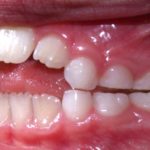
A number of factors are associated with the dentofacial characteristics of the developing child in the early years. Some believe that myoskeletal and myofunctional problems related to swallowing patterns, tongue position oral habits and breathing patterns are the consequence of malocclusion which other are of the view that the functional and environmental equilibrium of a structure is the primary cause for the dentoalveolar and dentoskeletal relationships. A number of myofunctional treatment protocols have been suggested for resolving orofacial dysfunction and myoskeletal problems.
The aim of this review was to assess the effect of early orthodontic management and orofacial muscle training protocols in the developing dentition, on (a) anterior open bite correction, as well as on (b) normalization of the patterns of mouth breathing, (c) swallowing and (d) tongue resting position and pressure.
Methods
Searches were conducted in the Medline/PubMed, Cochrane Central Register of Controlled trials (CENTRAL) LILACS, Clinical Trails.gov and National Research Register (www.controlled-trials.com) (ISRCTN registry). Randomised controlled trials (RCTs) or controlled clinical trials (CCTs) with a control group or at least two intervention groups involving treatments to correct myofunctional/myoskeletal problems, including non-nutritive oral habits, mouth breathing, tongue thrust, swallowing pattern, presence of hypertrophic tonsils/adenoids and speech related problems were considered.
A single reviewer extracted data for checking by a second reviewer with risk of bias being assessed by two reviewers independently using with the Cochrane tool. Standardised mean differences (SMDs) and 95% confidence intervals (CI) were calculated for cephalometric measurements and random effects meta-analysis conducted.
Results
- 15 studies (8 RCTs, 7CCTs) were included.
- 9 studies (2 RCTs, 7CCTs) were considered to be a high risk of bias, the remaining 6 RCTs at unclear risk.
- Interventions assessed included; functional appliances accompanied by lip sealing exercises, orthodontic tongue crib/spur appliances in conjunction with chin cup orthopaedic therapy, or alone; surgical removal of nasopharyngeal lymphoid tissue; muscle training protocols, combined or not with adenoids and/or tonsils removal and orthodontic appliances
- A narrative summary of the findings was provided.
- 2 studies contributed to a meta-analysis showing no evidence to support bonded lingual spurs over banded fixed appliances for the correction of anterior open bite in mixed dentition children presenting non-nutritive oral habits at the onset of treatment; SMD= -0.03 (95%CI; -.81 to 0.74)
Conclusions
The authors concluded
- The main interventions applied to correct myofunctional and myoskeletal problems in children included nasopharyngeal lymphoid tissue removal, orthodontic appliances, muscle training programmes or combinations of the above. The findings of this review may be generalisable to children in the primary or mixed dentition.
- There is a lack of high-quality evidence in the existing literature with regard to early orthodontic management and myofunctional treatment in the developing dentition.
- There was no evidence to support a bonded spur appliance over a fixed banded approach (either tongue crib or spurs) for the correction of anterior open bite problems in mixed dentition patients.
Comments
The reviewers have carried out a search of a number of databases to identify studies to address this question. However, because of the limited number of studies identified, the range of interventions and the low quality of the available studies the findings should be viewed cautiously.
In relation to the treatment of anterior open bite whilea number of systematic review are available, including a Cochrane review, all highlight the weakness of the available evidence.
Links
Primary Paper
Koletsi D, Makou M, Pandis N. Effect of orthodontic management and orofacial muscle training protocols on the correction of myofunctional and myoskeletal problems in developing dentition. A systematic review and meta-analysis. Orthod Craniofac Res. 2018 Aug 27. doi: 10.1111/ocr.12240. [Epub ahead of print] Review.PubMed PMID: 30152171.
Other references
Lentini-Oliveira DA, Carvalho FR, Rodrigues CG, Ye Q, Hu R, Minami-Sugaya H, Carvalho LBC, Prado LBF, Prado GF. Orthodontic and orthopaedic treatment for anterior open bite in children. Cochrane Database of Systematic Reviews 2014, Issue 9. Art. No.: CD005515. DOI: 10.1002/14651858.CD005515.pub3.
Dental Elf – 10th Aug 2016
Dental Elf – 20th Aug 2015
Anterior open bite: limited evidence for current treatment approaches
Picture Credits
By Giorgio Fiorelli at the English language Wikipedia, CC BY-SA 3.0,
